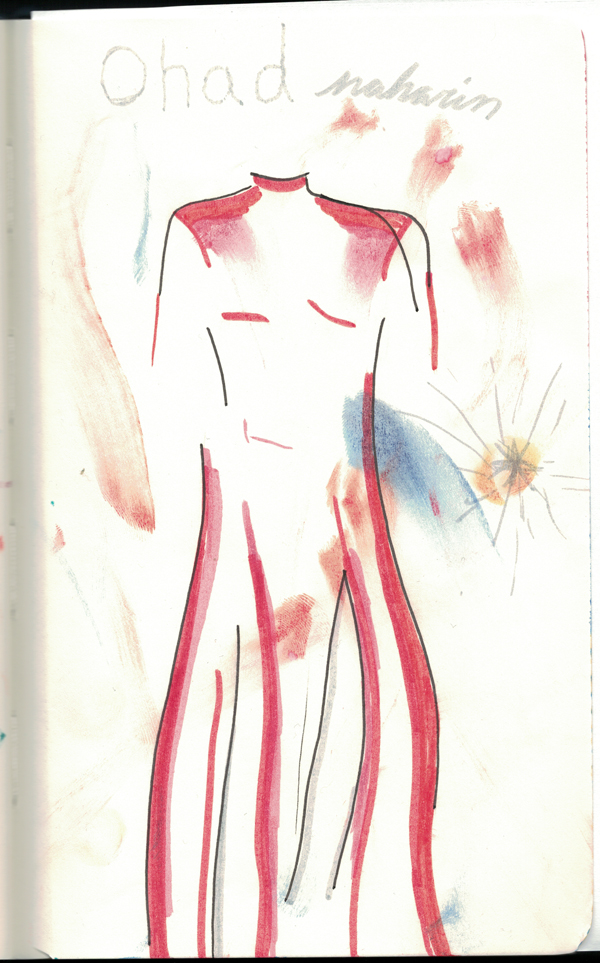James Turrell in Berlin – Original Light is Darkness
Yesterday I went to the Jewish Museum in Berlin with my best friend Kai to experience the James Turrell light installation, Aural.
You walk into a large room, all white. The floor slopes gradually down and away, until it meets what seems like an opening into another space or another wall. The white room is illuminated from behind you with soft blue light. The wall in front subtly blends with the space, so that sometimes the edges dissolve entirely and you are no longer contained.
The space in front ethereally changes color. It is a subtle mixture of light. It is like the ethers are mixing, the chalky blue luminousness from behind and the colored light from the center. How is it is possible for the ethers to mix – ether is continuous, it has no boundaries. How can it mix with something else?
Here is a gradient of light in a space with no boundaries. The gradient cannot be broken down into a spectrum with discrete sections. The light gradient is infinite.
So Turrell has put infinity into a finite space.
(Digitization is the process of breaking reality into finite pieces. The digital is always dependent on the analogue. Reality is analogue.)
People are like moths drawn to the light. And we are behaving like chimpanzees. Because it is not apparent whether there is a wall in front of us or whether it drops off into an open space, we cannot resist the urge to move closer, to take hold of the wall and determine what it is. An alarm sounds whenever a visitor gets too close to the edge. The younger visitors, especially, seem unable to control their curiosity.
The alarm becomes distracting.
Wanting to know what is in front of me is disrupting the purity of experience. We quell the need to grab onto reality, and we can experience the light now.
The strange thing about this light, Kai remarks, is that it is like darkness. Being here feels like having your eyes closed. But it is filled with light. There are no distinctions in darkness, no edges, no objects. It is the same with this light here. There are no edges. It is like the original darkness. Light that is darkness.
From the beginnings of philosophy, in Greece, light – the sun – has been equated with reason, the faculty of thought. Light is truth. Light divides the darkness. But the source of light is darkness: pure light does not discriminate. It is empty. There is nothing.
In the plenitude of this pure light, I am in contact with something invisible.
Pure light is the invisible. It is nothing.
You begin to project into the nothingness, Kai thought. When there is nothing, you are confronted with your self. You recognize your self. You do that when you see your projections into nothingness. (In the traditions of the East there is the darkness retreat: you spend days in total darkness. This is supposed to teach you something.)
Sometimes you can see the edges in the room. Sometimes you cannot see the edges at all. People are moving towards the ether again, setting off the alarm. Is there a hole in front of us or is this a wall?
There is something irresistible about holes. It is like the mystery of sex, Kai said. You go into something and have a sensation, but you cannot see it and do not know what it is. This is so intense for us. We try to find the hole in reality.
But there can’t be any holes in reality. In the whole of reality there is no hole: What would define the hole from the outside? We poke a hole in reality – all of a sudden we have a finite framework again, the edges are there again. We feel lost in infinity. Yet it is our home.
It is the edgelessness that we cannot stand. The edgelessness of pure light.
Being in this space feels like having your eyes closed and it is flooded with light.
Kai said she felt sad about leaving. We were leaving this thing that had become a thing. We had somehow assigned qualities to it.
You reify this and become attached to experiencing the luminous.
You need to know, disrupting the experience of this light. The impulse to grab and hold onto the purity of experience, attachment.
There was some text in a brochure at the exhibition. In an interview, Turrell muses that he is most fascinated by the light in our dreams. Where does it come from?
I ask, What is a mind without edges?


